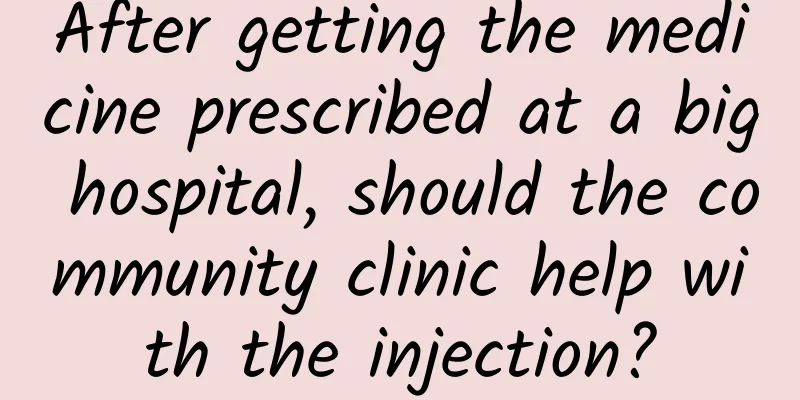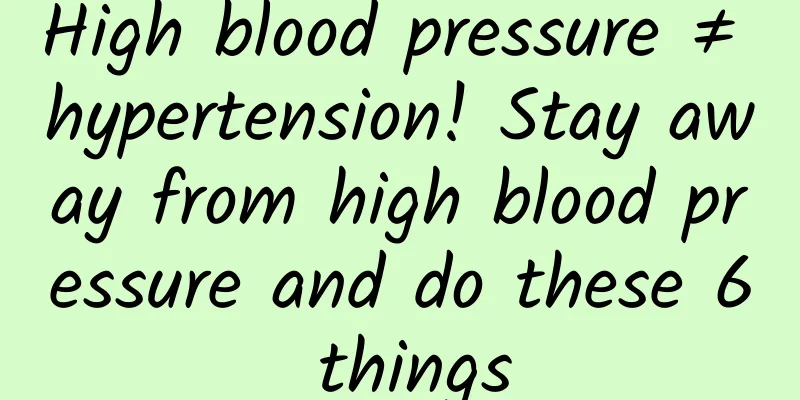After getting the medicine prescribed at a big hospital, should the community clinic help with the injection?

|
Recently, there was news that an elderly man was refused an injection after being prescribed medicine at a large hospital. This news became a hot topic. The picture comes from the Internet Many friends also expressed their views on this, and there were two different opinions that collided very fiercely: One view is that the elderly are old and have difficulty moving, and it is inhumane and lacking in service attitude for the community clinic to refuse to inject the medicine just because the medicine is not prescribed by them. Another point of view is that community clinics have certain limitations in terms of facilities and capabilities to prevent injection risks. In order to ensure the safety of injections for the elderly and to receive timely treatment when serious adverse reactions occur, it is understandable that they refuse injections. So, in daily life, is it really feasible to go to a community clinic for an injection after getting an injectable medication prescribed at a large hospital? 01 The answer to whether or not to inject is not simple We cannot say which of the two viewpoints mentioned above is right or wrong, because they are actually drawn from different standpoints and different perspectives. We can only analyze the specific situation and cannot simply choose one of the two. This is related to the health and even the life of the patient, so we cannot be careless at all. Whether or not to give an injection is difficult to generalize because each patient's physical condition, illness, and medication are different. If the community clinic has a relatively good understanding of the patient's specific situation, has the relevant qualifications and conditions for injections, and the injected drugs are relatively safe and low-risk, then of course the injection can be given. However, if the patient's physical condition is unknown, or if the clinic lacks the relevant injection capabilities, or does not have the ability to treat possible adverse reactions after the injection, then it is understandable that the clinic will take a cautious attitude. It may be safer to let a doctor who understands the situation give the injection | Tuchong Creative Some friends may still be a little confused. Isn't it just a matter of acupuncture? Why is there so much to it? 02 Injection, which carries a higher risk When it comes to "injections", we are all familiar with them. Many times when we are sick, we need an injection. However, injections, whether subcutaneous, intramuscular, intravenous or other injection methods, are more risky than oral medications. So what is the difference between the two? Oral administration is a basic way of taking medicine and is relatively safer. After the drug enters the human body through oral administration, most of them will undergo initial metabolism in the liver, and then enter the blood and exert relevant effects through blood circulation. This "first-pass effect" of the liver avoids some adverse reaction risks caused by direct absorption of the drug, and it is also a completely non-invasive way of administering the drug. Moreover, if adverse reactions occur after oral medication, the absorption of the drug can be quickly prevented by means such as gastric lavage. "Intravenous drip" is actually a kind of injection drug administration | Tuchong Creative Injection is different. First, injection is an invasive way of administration. Second, injection allows for quicker and more direct absorption of the drug. Although this may be faster and more effective in terms of drug action, it may also increase the risk of adverse reactions. Once an adverse reaction occurs, it is difficult to remove the drug that has entered the blood vessels. These aspects require attention. Therefore, there is a principle of medication: if you can take it orally, don’t inject it. Whether it is intramuscular injection or intravenous injection (including "drip"), it should not be abused. 03 What are the risks of injectable medication? Taking the most common intravenous injection as an example, the possible risks of medication are mainly the following: u Intravenous injection is an invasive method of drug administration. It can cause lesions in the veins, trigger an inflammatory response in the vascular endothelium, and may also cause inflammation of the superficial veins. u Intravenous injection requires higher aseptic operation requirements. If the aseptic operation is not standardized, there may be a risk of wound infection through the injection needle or other instruments. Doctors wearing sterile gloves is a common aseptic operation | Tuchong Creative u Intravenous injection needs to be combined with the patient's physical condition and the type of drug used to control the drip rate. If the drip rate is too fast, it will cause a rapid increase in blood volume and increase the heart load. On the other hand, a large amount of drugs quickly enter the body, exceeding the body's tolerance, which may bring serious risks of adverse reactions. u Although the quality control of drugs is becoming more and more stringent, it is impossible to completely remove insoluble tiny particles in intravenous injections. If large amounts of infusions are frequently given, more particles will enter the human body with the injections. They are usually difficult to degrade and remain in the human body for a long time, which may cause local circulation disorders and bring chronic health hazards. u In rare cases, intravenous infusion may cause severe adverse reactions such as high fever and convulsions. Although this rarely happens, such risks should be noted. When it comes to injectable medication, children and the elderly are two risk groups that should receive special attention. Children's bodies are still in the development stage, and some of their tissues and organs are not yet mature in their ability to metabolize drugs. The probability of risks occurring when intravenous drugs enter the body is also higher. The elderly's body's ability to metabolize and absorb drugs will decrease, and their ability to tolerate drugs directly entering the body will also decrease. Therefore, when choosing a medication method for children and the elderly, they should also consider the situation and carefully choose intravenous infusion. Elderly people need to pay extra attention to their physical condition when getting injections | Tuchong Creative In addition, intramuscular injection often causes local redness, swelling and pain, and in rare cases may lead to adverse reactions such as nodules or purpura. Therefore, it is often used for immunization, and regular administration is relatively rare. 04 Injection is only used in these cases In what cases should injection be used? In the following three cases, you may consider injecting the drug. First of all, if the patient is seriously ill and oral medication cannot provide timely treatment, administration by injection can often take effect faster and achieve emergency treatment. Secondly, if the patient is unable to take the drug orally (for example, severe vomiting and diarrhea), and the condition cannot be effectively controlled without drug treatment, injection can be considered. Finally, some drugs, when taken orally, will become ineffective due to the effects on the digestive system, so they need to be administered by injection. For example, drugs such as insulin can only be administered by injection at present. 05 Don’t fall for these two misunderstandings After talking about the risks and principles of injection medication, let me tell you about two common misunderstandings about injection medication. If the condition is not critical, it is better for children to take oral medication as much as possible | Tuchong Creative Myth 1: Children get better quickly after getting an injection This "get better quickly" mentality has led to a lot of abuse of infusions. Especially when children are sick, whether it is a cold or a cough, there are always some people who ask for injections quickly, thinking that injections will make them get better quickly. Injections and infusions do allow the drug to be absorbed faster, but this does not mean that the condition will get better faster. It may also bring the above-mentioned multi-faceted injection safety risks, which is a completely unnecessary over-medical behavior. If the condition is not serious and can be controlled by oral medication, oral medication should be chosen as much as possible. Don't let our impatience harm the child. Myth 2: Infusions once or twice a year can help clear blood vessels in the elderly This idea of using fluids to clear blood vessels seems to make sense, but in fact, the plaques on the blood vessels are all lipid "garbage" formed under the inner membrane of the blood vessel wall, and it is impossible to "wash them away" through fluid infusion. The fluid circulation system itself is also a closed pathway, and the goal of clearing blood vessels by flushing with glucose or saline is impossible to achieve. Moreover, additional infusions will also bring multiple risks such as infection and increased cardiac load, which is really not worth the cost. Injection is a common way of drug administration. It has its risks and scope of application and should be used reasonably. Finally, it should be emphasized that oral administration is better than injection. When injecting, you must choose a qualified medical institution to better ensure the safety of medication. Author | Li Jin, deputy chief pharmacist, deputy leader of the Youth Studies Group of the Medical Committee of the China Science Writers Association Review | Liu Guiyang, Chief Pharmacist, Fourth Medical Center, PLA General Hospital Editor | Jiang Fan Editor | Ding Zong This article is produced by the "Science Rumor Refutation Platform" (ID: Science_Facts). Please indicate the source when reprinting. The pictures in this article are from the copyright gallery and are not authorized for reproduction. |
<<: Do you know the hidden ways to play the commonly used mobile phone apps?
>>: The boulder is from an alien planet? It's you who are from outer space!
Recommend
Birds are experts in eating spicy food! Why are they not afraid of spicy food?
There are many interesting phenomena hidden in th...
Black hat Taobao virtual selling project, video tutorial on how to earn 5000+ per month with a single store!
Black hat Taobao virtual selling project, a singl...
LG G6 disassembly: Heat pipe cooling suppresses Snapdragon 821
LG officially released its new phone LG G6. LG G6 ...
Moonlight: Let your phone play PC games
Nowadays, mobile games are becoming more and more...
Aiti Tribe Stories (7): Meet 51CTO and aim high
[51CTO.com original article] The protagonist of t...
Zhihu product operation analysis
From a vertical knowledge community loved by prof...
Zhihu advertising, Zhihu advertising forms
Zhihu community is the largest knowledge platform...
How to monetize short videos in the medical and health field?
In the past few months, we have participated in t...
Developers' Notes: Hot Topics in Mobile Development in 2015
It has been 8 years since Steve Jobs launched the...
Why is mobile banking important to the banking industry?
With the popularity of mobile banking, people hav...
Get the most out of these 3 types of users and solve your promotion problems!
The categories of operations include data operati...
Do you know what threats your mobile devices face?
Phishing and scams When phishing occurs, cybercri...
Researching new materials with AI is fast
Chen Sijin With the rapid development of artifici...
SEO expert Zeng Liang Pinbei English Google SEO tutorial worth 8,000 yuan (Baidu network disk)
The official price of English SEO tutorial is 8,0...
6000 words of essence, methodology to improve homepage conversion rate
In the second half of the Internet, when the traf...





![[Must-Read for Internet People] After a few years in the industry, where should your future be?](/upload/images/67cc42c5e1aee.webp)



